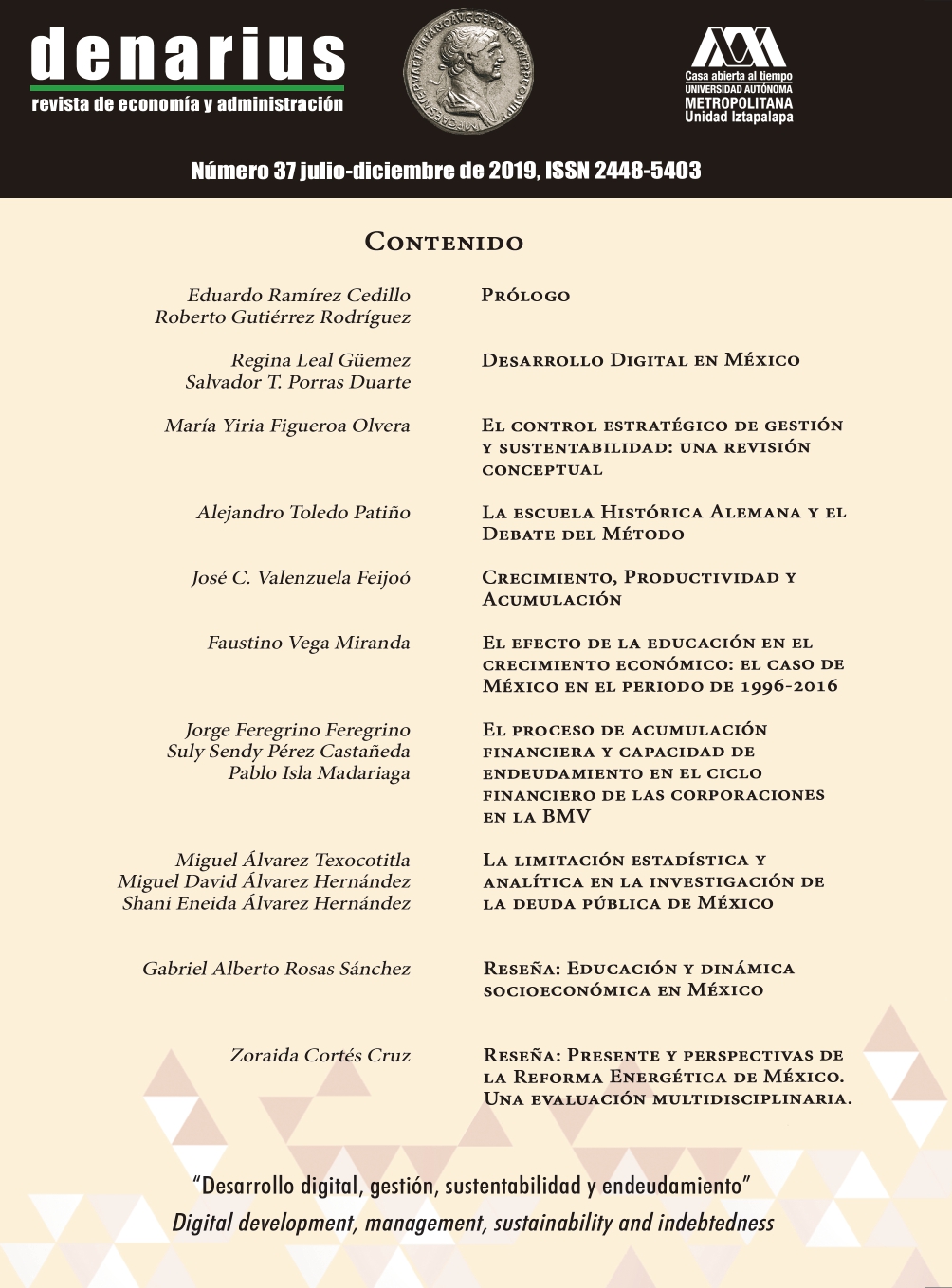El proceso de acumulación financiera y la capacidad de endeudamiento en el ciclo financiero de las corporaciones bursátiles que cotizan en la BMV
Abstract
Corporations have reoriented their financing strategies, during the financialization process, to increase their borrowing capacity and establish speculative financial strategies during the financial cycle. The objective of this paper is to analyze the process of financial accumulation during the financial cycle and under a context of financialization. The inclusion of the endogenous money theory and the hierarchy in the financing structure allow us to identify the strategies used to accumulate financial resources in corporations. The analysis will be carried out using a dynamic econometric model with panel data applied to 26 BMV corporations during the period 2002-2014. In these corporations, the results show that the indebtedness behavior is cumulative and is led by the financial cycle.
Downloads
References
Adrian, T; y Liang, N. (2016). “Monetary Policy, Financial Conditions, and Financial Stability Federal Reserve Bank of New York Staff Reports”, núm. 690.
Aglietta, Michael. (2000). “La globalización financiera”. SELA, núm. 59, mayo-agosto, pp. 6-21.
Akıncı, Ö. (2013). “Global financial conditions, country spreads and macroeconomic fluctuations in emerging countries”. Journal of International Economics, vol. 91, núm. 2, pp. 358-371.
Argitis, G. y Pitelis, C. (2008). “Global finance and systemic instability”. Contributions to political Economy, vol. 27, núm.1, pp. 1-11.
Arrighi, Giovanni. (2003). “The Social and Political Economy of Global Turbulence”. New Left Review, núm. 20, pp. 5-71.
Aybar, C; Casino, A; López, J. (2001). “Jerarquía de preferencias y estrategia empresarial en la determinación de la estructura de capital de la pyme: un enfoque con datos de panel”. Working paper.
Birch, Kean. (2016). “Market vs. contract? The implications of contractual theories of corporate governance to the analysis of neoliberalism”. Ephemera Theory and Poitics in the Organization, vol. 16, núm.1, february, pp. 1-27.
Bond, Steve. (2002). “Dynamic panel data models: a guide to micro data methods and practice”. Portuguese Economic Journal, vol. 1, núm. 2, pp. 141-162.
Borio, Claudio. (2012). “The financial cycle and macroeconomics: What have we learnt?”. BIS Working Papers, núm. 395.
______. (2019). “On money, debt, trust and central banking”. Bank for International Settlements, núm. 763.
Boyer, Robert. (2000). “Is a finance-led growth regime a viable alternative to Fordism? A preliminary analysis”. Economy and Society, vol. 29, núm. 1, pp. 11-45.
Boyer, Robert. (2005). “From Shareholder Value to CEO Power: The Paradox of the 1990s. Competition and Change”, núm. 9, pp. 7-47.
Bulan, L. y Yan, Z. (2009). “Test of Pecking Order Theory and the Firm Life Cycle”. Banking and Finance Letters. vol. 1, núm. 3, pp. 129- 140.
Castaingts, Juan. (2015). Dinero poder y trabajo. México: Antrophos, Siglo. XXI.
Castaingts, Juan. (2017). Simbolismos del dinero. Antropología y economía: una encrucijada. 2ª Ed., México: Antrophos, Siglo XXI.
Commendatore, P; Panico, C; y Pinto, A. (2009). “The influence of different forms of government spending on distribution and growth”. Metroeconomica, vol. 62, Issue 1, pp. 1-23.
Dillard, Dudley. (1980). “A Monetary Theory of Production: Keynes and the Institutionalists”. Journal of Economic Issues, vol. 14, núm. 2, pp. 255-273.
Dillard, Dudley. (1942). “Silvio Gesell’s Monetary Theory of Social Reform”. American Economic Review, vol. 32, núm. 2, pp. 348–352.
Dore, Ronald. (2008). “Financialization of the Global Economy, Industrial and Corporate Change”, vol. 17, núm. 6, pp. 1097-1112.
Fama, E; y French, K. (2005). “Financing decisions: Who issues stock?”. Journal of Financial Economics, núm. 76, pp. 549-582.
Feregrino, J; Isla, P; Rodrigues, C. (2017). “El ciclo financiero en las organizaciones: de las fallas estratégicas y su lógica fraudulenta”. En Estudios Empresariales: retos, logros. Castañeda, S. y Fergrino, J. (coords.). México: Ed. Fontamara.
Foster, J. y Magdoff, F. (2009). The Great Financial Crisis: Causes and Consequences. New York: NY: Monthly Review Press.
Demir, Firat. (2007). “The Rise of Rentier Capitalism and the Financialization of Real Sectors in Developing Countries”, Review of Radical Political Economy, vol. 39, núm. 3, pp. 351-359.
Gompers, Paul. (1995). “Optimal investment, monitoring, and the staging of venture capital”. Journal of Finance, núm. 50, pp. 1461- 1489.
Hamilton, R; y Fox, M. (1998). “The financing preferences of small firm owners”. International Journal of Entrepreneurial Behaviour & Research, vol. 4, núm. 3, pp. 239-248.
Holmes, S. y Kent, P. (1991). “An Empirical analysis of the financial structure of small and large Australian manufacturing enterprises”. Journal of Small Business Finance, vol. 1, núm. 2, pp. 141-54.
Holmstrom, B. (2015). “Understanding the role of debt in the financial system“. Bank for International Settlements, núm. 479.
Karadeniz, E; Kandir, S; Iskenderoglu, O; Onal, Y. (2011). “Firm size and capital structure decisions: evidence from Turkish Lodging companies”. International Journal of Economics and Financial Issues, vol. 1, núm. 1, pp. 1-11.
Keynes, John. (1936). La Teoría General de la Ocupación el Interés y el Dinero. México: Fondo de Cultura Económica.
Keynes, John. (1938). “Mr. Keynes finance. The economic journal. June. In the General Theory and after. Part II defense and development. The collected Writings of John Maynard Keynes”. Mc Millan Press, Royal Economic Society 1973.
Kliman, Andrew. (2012). The Failure of Capitalist Production: Underlying Causes of the Great Recession. London: Pluto Press.
Krznar, M. y Matheson, M. (2017). Financial and business cycles in Brazil. International Monetary Fund.
Labra, R., y Torrecillas, C. (2018). “Estimating dynamic Panel data. A practical approach to perform long panels”. Revista Colombiana de Estadística, vol. 41, núm. 1, pp. 31-52.
Lazonick, William. (2007). “The US stock market and the governance of innovative enterprise”. Industrial and Corporate Change, vol. 16, núm. 6, pp. 983-1035.
Lazonick, William. (2017). “Innovative Enterprise Solves the Agency Problem: The Theory of the Firm, Financial Flows, and Economic”. Institute for economic Thinking. WP, núm. 65.
McLeay, M; Radia, A; y Thomas, R. (2014). Money creation in the modern economy. Bank of England Quarterly Bulletin, Q1.
McKenzie, D. y Millo, Y. (2003). “Constructing a Market, Performing Theory: The Historical Sociology of a Financial Derivatives Exchange”. American Journal of Sociology, vol. 109, núm. 1 July, pp. 107-145.
Michaelas, N; Chittend, F; Poutziouris, P. (1999). “Financial policy and capital structure choice in U.K. SMEs: Empirical evidence from company panel data”. Small Business Economics, núm. 12, pp. 113- 130.
Minsky, Hyman. (1975). John Maynard Keynes. New York: Columbia University.
Miyazaki, Hirokazu. (2007). “Between arbitrage and speculation: an economy of belief and doubt”. Economy and Society, vol. 36, núm. 3, pp. 396-415.
Modigliani, F y Miller, M. (1958). “The cost of capital, corporation finance and the theory ofinvestment”. American Economic Review, núm. 48, pp. 261-297.
Morales, José. (2009). “Análisis de los instrumentos financieros derivados en la Bolsa Mexicana”. Economía Informa, núm. 361, noviembre- diciembre, pp. 112-125.
Mugosa, Ana. (2015). “The determinants of capital structure choice: evidence from Western Europe”. Business and Economic Horizons, vol. 11, núm. 2, pp. 76-95.
Myers, S. y Majluf, N. (1984). “Corporate financing and investment decisions when firms have information that inverstors do not have”. Journal of Financial Economics, vol. 13, pp. 187-221.
Orhangazi, Ozgur. (2008.) “Financialization and Capital Accumulation in the Nonfinancial Corporate Sector: A Theoretical and Empirical Investigation on the US Economy, 1973-2003”. Cambridge Journal of Economics, vol. 32, núm. 6, pp. 863-886.
Parguez, Alain. (2004). “Moneda y crédito en el capitalismo contemporáneo”. En Economía financiera y contemporánea II, Correa, E. y Girón, A. México: Porrúa.
Persons, J. y Warther, V. (1997). “Boom and Bust Patterns in the Adoption of Financial Innovations”. The Review of Financial Studies, vol. 10, núm. 4, pp. 939-967.
Qureshi, M; Sheikh, N; y Khan, A. (2015). “A revist of pecking order theory versus trade off theory: evidence from Pakistán”. Pakistan Journal of Commerce and Social Sciences, vol. 9, núm. 2, pp. 344- 355.
Rey, Héléne. (2015). “Dilemma not Trilemma: The global Financial Cycle and Monetary Policy Independence”. NBER Working Paper, núm. 21162.
Rochon, Louis. (1999). Credit Money and production: An alternative Post Keynesian Approach. Cheltenham: Edward Publishing.
Rochon, Louis. (2007). “The state of Post Keynesian interest rate policy: where are we and where are we going?”. Journal of Post Keynesian Economics / Fall, vol. 30, núm. 13, pp. 3-11.
Rungcharoenkitkul, P. Borio, C. y Disyatat, P. (2019). “Monetary policy hysteresis and the financial cycle”. BIS Working Papers, núm. 817.
Sarlija, N. y Harc, M. (2016). “Capital structure determinants of small and medium enterprises in Croatia”. Manging Global Transitions: International Research Journal, vol. 14, núm. 3, pp. 251-266.
Scherr, F. Sugrue, T. y Ward, J. (1990). “Financing the small firm startup: determinants of debt use”. The Journal of Entrepreneurial Finance, vol. 3, núm. 1, pp. 17-36.
Sraffa, Piero. (1926). “The laws of return under competitive conditions”. Economic Journal, núm. 44, pp. 535-550.
Shyam-Sunder, L. y Myers, C. (1999). “Testing static tradeoff against pecking order models of capital structure”. Journal of Financial Economics, núm. 21, pp. 219-244.
Talberg, M., Winge, C., Frydenberg, S. y Westgaard, S. (2008). “Capital structure across industries”. International Journal of the Economics of Business. vol. 15, núm. 2, pp. 181-200.
Terrero, D. D. y Sattler, S. A. (2015). “Estudio comparativo de la estructura de financiación de las empresas del panel Pymes con las del panel General-Mercado de Valores de Argentina”. Gestión Joven, vol. 13, pp. 55-71.
Toporowski, Jan. (2005). Theories of financial Disturbance. An examination of Critical Theories of FInance form Adam Smit ot the Present Day. Masschusetts : Edward Elgar Publishing.
Tulum, Ö., & Lazonick, W. (2018). “Financialized corporations in a national innovation system: The US pharmaceutical industry”. International Journal of Political Economy, vol. 4, núm. 3-4, pp. 281- 316.
Veblen, Thorstein. (1898). “The beginnings of ownership”. The American Journal of Sociology, vol. 4, núm. 3, pp. 352-365.
Veblen, Thorstein. (1904). The Theory of Business Enterprise. Nueva York: Charles Scbriner's Sons.
Veldman, Jeroen. (2013). “Politics of the corporation”. British Journal of Management, vol. 25, pp. 18-30.
Wolfson, Martin. (1996). “A post keynesian theory of credit rationing”. Journal of Post Keynesian Economics, vol. 18, núm. 3, pp. 443-470.
Zoltan, J. y Kumhof, M. (2015). “Banks are not intermediaries of loanable funds-and why this matters”. Bank of England Working Paper, núm. 529.














